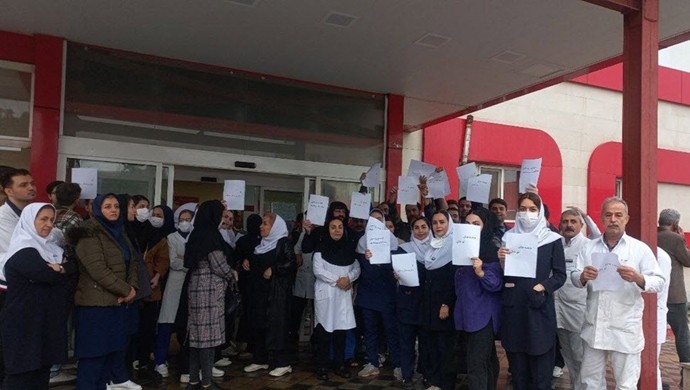
Over the past few days, Iran has witnessed a wave of protests by medical staff in several cities,voicing their frustration over livelihood issues, including unpaid overtime and insufficientwages. Nurses from Sanandaj, Rasht, Kermanshah, Eslamabad-e Gharb, and Yazd have ralliedto protest against unpaid experience bonuses and tariffs from 2022.
These protests have beenmarked by strong slogans against the government, as seen in videos circulating on social media,where nurses in Yazd criticized health officials directly in front of the city’s governorate.This series of protests is not a first for Iran’s nurses. In recent months, medical staff in Sanandajvoiced their discontent, rallying in front of Kurdistan University of Medical Sciences.
November 20—Sanandaj, western #Iran
Nurses hold rally, protesting poor wages, unpaid salaries, and forced extra-hour work.#IranProtests pic.twitter.com/9s04Vd6Ljg— People's Mojahedin Organization of Iran (PMOI/MEK) (@Mojahedineng) November 20, 2023
Their chants, “Nurses, shout your rights!” and “Tariffs are paid in rials, but expenses are in dollars, “highlight the economic strain they face. The severity of the situation was underscored by Mohammad Sharifi Moghaddam, Secretary General of The Nurse’s Home (Khaneye Parastar). He revealed that over 90 percent of nurses are dissatisfied with their jobs, noting a dire shortage of nurses that has even led to patient fatalities.
A state-run ILNA news agency report detailed the plight of a nurse who received a
paltry sum for substantial overtime work, further taxed by the government.
The Mehr News Agency also reported on the low salaries and staffing issues in the medical
sector, illustrating the meager compensation for forced overtime.
November 19—Ahvaz, southwest #Iran
Oil industry workers hold protest rally as regime authorities continue to ignore their demands for better wages and working conditions.#IranProtestspic.twitter.com/RynZoaSHtJ— People's Mojahedin Organization of Iran (PMOI/MEK) (@Mojahedineng) November 19, 2023
Iran’s nursing crisis, exacerbated by the COVID-19 pandemic, has led to repeated protests in various cities. Nurses have been vocal about their job status and the need for change.
Concurrently, part-time workers from the Oil Ministry in Ahvaz have also protested,
demanding better remuneration and working conditions. Their demands include the full
implementation of 2021 resolutions, modification of payment formulas, correction of overtimerates, and adjustments in New Year bonuses.
Furthermore, over the weekend, retirees from various sectors, includin telecommunications, steel, and the Social Security Organization, took to the streets. Despite legal obligations, the government has failed to adjust pensions in line with living costs, plunging many retirees into poverty.
November 19—Shush, southwest #Iran
Retirees of the Social Security Organization resume protest rallies, demanding higher pensions according to the rising costs of living.#IranProtestspic.twitter.com/SHCa69fRVf— People's Mojahedin Organization of Iran (PMOI/MEK) (@Mojahedineng) November 19, 2023
These widespread protests across different sectors in Iran reflect the escalating inflation and increasing cost of living, coupled with the government’s failure to meet the basic livelihood needs of its people. Although these gatherings sometimes face crackdowns and arrests by security forces, the protests have continued to grow, signaling a deep-rooted dissatisfaction within various facets of Iranian society.

MEK Iran (follow us on Twitter and Facebook), Maryam Rajavi’s on her site, Twitter & Facebook, NCRI (Twitter & Facebook), and People’s Mojahedin Organization of Iran – MEK IRAN – YouTu







